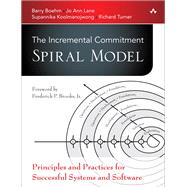
What is included with this book?
Dr. Richard Turner has over thirty years of experience in systems, software and acquisition engineering. He is currently a Distinguished Service Professor at the Stevens Institute of Technology in Hoboken, New Jersey, and a Principle Investigator with the Systems Engineering Research Center. Although on the author team for CMMI, Dr. Turner is now active in the agile, lean and kanban communities. He is currently studying agility and lean approaches as a means to solve large systems issues. Dr. Turner is a member of the Executive Committee of the NDIA/AFEI Agile for Defense Adoption Proponent Team, the INCOSE Agile SE Working Group, and was an author of the new IEEE Computer Society/PMI Software Extension for the Guide to the PMBOK that spans the gap between traditional and agile approaches. He is a fellow of the Lean Systems Society, a Golden Core awardee of the IEEE Computer Society, and co-author of three other books: Balancing Agility and Discipline: A Guide for the Perplexed, co-written with Barry Boehm, CMMI Survival Guide: Just Enough Process Improvement, coauthored with Suzanne Garcia, and CMMI Distilled.
Jo Ann Lane is currently the systems engineering Co-Director of the University of Southern California Center for Systems and Software Engineering, a member of the Systems Engineering Research Center (SERC) Research Council representing the system of systems research area, and emeritus professor of computer science at San Diego State University. Her current areas of research include system of systems engineering, system affordability, expediting systems engineering, balancing lean and agile techniques with technical debt, and innovation in systems engineering. Previous publications include over 50 journal articles and conference papers. In addition, she was co-author of the 2008 Department of Defense Systems Engineering Guide for Systems of Systems and a contributor to the Systems Engineering Body of Knowledge (SEBoK). Prior to her current work in academia, she was a vice president in SAIC’s Healthcare and Software and Systems Integration groups.
Dr. Supannika Koolmanojwong is a faculty and a researcher at the University of Southern California Center for Systems and Software Engineering. Her primary research areas are Systems and Software Process Modeling, Software Process Improvement, Software Process Quality Assurance, Software Metrics and Measurement, Agile and Lean Software Development and Expediting Systems Engineering. She is a certified ScrumMaster and a certified Product Owner. Prior to this, she was a software engineer and a RUP/OpenUp Content Developer at IBM RationalSoftware Group.
FOREWORD BY FRED BROOKS
PREFACE
INTRODUCTION
PART I THE FOUR ICSM PRINCIPLES
CHAPTER 1 THE FIRST PRINCIPLE: STAKEHOLDER VALUE-BASED SYSTEM DEFINITION AND EVOLUTION
CHAPTER 2 THE SECOND PRINCIPLE: INCREMENTAL COMMITMENT AND ACCOUNTABILITY
CHAPTER 3 THE THIRD PRINCIPLE: CONCURRENT MULTIDISCIPLINE SYSTEMS DEFINITION AND DEVELOPMENT
CHAPTER 4 THE FOURTH PRINCIPLE: EVIDENCE-BASED AND RISK/OPPORTUNITY-BASED DECISIONMAKING
PART II. ICSM STAGES AND PHASES
CHAPTER 5 STAGE IOVERVIEW
CHAPTER 6 STAGE II OVERVIEW
PART III: THE ICSM PROCESS DECISION TABLE WITH 10 RISK-DRIVEN COMMON CASES
CHAPTER 7 OVERVIEWOF PROCESS DECISIONSFOR 10COMMON CASES
CHAPTER 8 SMALL CUSTOM SOFTWARE SYSTEMS
CHAPTER 9 NDI AS A WILDCARD
CHAPTER 10 LARGER,MORE COMPLEX HARDWARE/SOFTWARE SYSTEMS
APPENDIX 1 -CASE STUDIES
APPENDIX 2 -MAPPINGS OF ICSM TO STANDARDS AND MODELS
APPENDIX 3 -GLOSSARY
APENDIX 4 –VALUE BASED ENGINEERING
The New copy of this book will include any supplemental materials advertised. Please check the title of the book to determine if it should include any access cards, study guides, lab manuals, CDs, etc.
The Used, Rental and eBook copies of this book are not guaranteed to include any supplemental materials. Typically, only the book itself is included. This is true even if the title states it includes any access cards, study guides, lab manuals, CDs, etc.